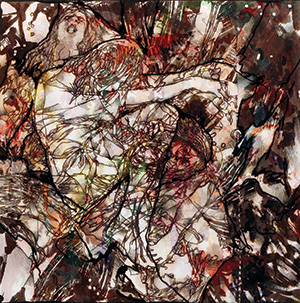

Inside Anno Domini, the gallery already boasting one of those ominous Latin monikers, Barron Storey tells me that suicide is not a great way to promote an art show. The show is ugly, he says. Just ugly.
In Storey’s case, he lost his mother, uncle, ex-wife and best friend, all to suicide. The details are too deep to include here, but as Storey began work on a graphic novel to explore his uncle’s suicide, the same uncle Storey idolized as a kid, the process involved interviewing many friends who themselves had known someone that committed suicide. So Storey drew the illustrations and integrated the text in his trademark fashion. What now unfolds on the wall at Anno Domini reads like a graphic novel, depicting people who took their own lives, including quotes, lurid details, imagery, facts, figures and contemplation. One portion of the show deals with the four previously mentioned people closest to him, while the rest of the work represents the results of those he interviewed. Nothing in the show is pretty; it’s a Goya-esque sprawl of self-inflicted brutality. However, the process of one lifelong artist interpreting an unusual amount of death, dealing with it through his art, results in a powerful and inspiring experience, at least for me.
“Like a lot of people who just want to hold on to their sanity, you find ways of dealing with it,” Storey tells me. “Ways of categorizing it, compartmentalizing it, or something like that, so it isn’t incapacitating to you. On a deeper level, it’s kind of always there. And when it happened repeatedly, as it has with me, you start trippin’. I started thinking: ‘What is this? Why is this something that I just have to accept? Why is this something that I can’t get any details about? Why is this something my relatives don’t want to say a single word about?’ So it gets bottled up.”
The bottle now spills all over the walls of Anno Domini. One piece depicts Storey’s friend who invited everyone over for his own birthday party, and then shot himself in front of everyone. Another painting, an abstract work, represents another friend who confessed to Storey that he’d killed his own father, suffocated him with a pillow, just because his father was too weak and bedridden to do it himself, which is what the person’s father had wanted.
Other works deal less with specific individuals, but more with facts and statements Storey heard from those he interviewed. “What is the most common form of suicide? Hanging.”—speculates one particular drawing, although Storey admits he doesn’t know if that’s true or not. MEN USE GUNS proclaims another one.
Several paintings explore the ambiguous nature of overdoses, contemplating whether or not we can ever really tell if the act was intentional or not. The role of drug addiction in the suicidal impulse emerges in specific interviews, especially those related to the music business. One painting even goes into the incessant glorification of death one witnesses in the darkest corners of the death metal scene.
“For my friend who’s in that scene too, the coolness of death is something that just puts it on the list of options,” Storey tells me.
Beginning the section of interview pieces, one sees a tongue-and-chic dialog, a spin on Dante, with a cluster of paintings dictating to Storey that he must draw all the suicides. At the end of the entire show, another dialog emerges, one expounding on Storey’s internal process of trying to get this out of his system, once and for all.
“It’s not been working, but I’m trying,” he confesses, adding that he wanted to cancel the exhibit, but continued at the gallery’s insistence. In the process, Storey says the spirits of the deceased suicides talked back to him through the paintings. They said things like: “How dare you. How dare you use my experience for your purposes. How dare you do that. How dare you tell things that I have not given you permission to tell.”
But Storey is telling the stories anyway. Permission or not.



